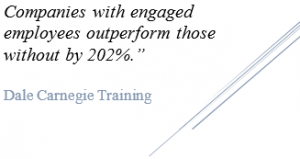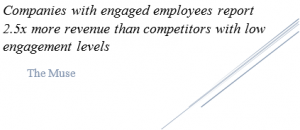 Employee’s that are engaged perform better than those that are not engaged. That is the word on the street, but what does that mean exactly? What does an engaged employee look like exactly? Like many terms or phrases in organizational development or organizational effectiveness the definition for employee engagement (EE) and how to go about effectively implementing an employee engagement program is often a bit fuzzy. If you are confused about where to start or even about your next steps, assuming you have already implemented an employee engagement strategy, you are not alone. In this article, we will discuss what EE is, and is not, and a few key things that you must know before implementing an EE strategy.
Employee’s that are engaged perform better than those that are not engaged. That is the word on the street, but what does that mean exactly? What does an engaged employee look like exactly? Like many terms or phrases in organizational development or organizational effectiveness the definition for employee engagement (EE) and how to go about effectively implementing an employee engagement program is often a bit fuzzy. If you are confused about where to start or even about your next steps, assuming you have already implemented an employee engagement strategy, you are not alone. In this article, we will discuss what EE is, and is not, and a few key things that you must know before implementing an EE strategy.
 Employee engagement is not employee satisfaction or taking the team out for drinks on Friday’s. Employee engagement is an employee’s intellectual (head) and emotional (heart) connection with an employer, demonstrated by motivation and commitment (hands) to positively impact the company vision and goals. As we all know employees support what they help create; and this is why employee engagement is so important to performance. What are the experts saying about the importance of employee engagement?
Employee engagement is not employee satisfaction or taking the team out for drinks on Friday’s. Employee engagement is an employee’s intellectual (head) and emotional (heart) connection with an employer, demonstrated by motivation and commitment (hands) to positively impact the company vision and goals. As we all know employees support what they help create; and this is why employee engagement is so important to performance. What are the experts saying about the importance of employee engagement?

Employee engagement influences so much more than just performance. It influences employee turnover, organizational culture, employee motivation and attitudes. As influential as EE is, the question isn’t whether you can afford to have an engagement strategy in place, the question is can you afford not to? Before you go forth and prosper, there are a few things you must know about EE. You must know the three necessary psychological conditions for engagement which are: meaning, safety, and capacity.
· Meaning – Employees can engage when they believe that immersing themselves in their work gives them value (purpose, money, status, influence, etc.)
· Safety – Employees can engage when they believe they can invest themselves in their work without fear of negative consequences to self-image, status, or career.
· Capacity – Employees can engage when they believe they feel capable of driving physical, intellectual, and emotional energy into their work.
Think about why you are where you are? You could work anywhere, but you probably stay because of one of the 3 psychological conditions. Do you find meaning in your work? Do you find that you can engage with others and in your work safely without fear of negative consequences? What about a time when you left a position or job? Did you have a tyrant for a boss or work for an organization that did not respect your safety or capacity? Your employees are no different than you. If you want your team to perform at their best or if you want to hire and retain top level talent; then you must have a structured employee engagement strategy. You will not be effective with a half-hearted attempt to engage your teams.
We will discuss these three crucial conditions more in-depth in our upcoming free training, but for now, understand that any EE strategy that does not take into consideration these 3 key conditions is not a true EE strategy and will not achieve your desired performance outcomes. Humans are more than just numbers on a paper. They are flesh and blood and a mixture of complex emotions. When you can engage an employee, and give them true meaning in their work, you will have unlocked the door to levels of culture and performance that you previously could only dream of. Those doors are not reserved only for the fortune 500 organizations. Your organization can walk through them as well.
Want to learn more about employee engagement? Then join our free monthly webinar training at the link below. We have partnered with Emplify to deliver impactful insights and interventions into employee engagement. The training is 100% free and requires no obligation. Availability is limited. So, sign up today!
We will cover a variety of important topics such as:
1. Some startling statistics about employee engagement.
2. Why happiness is not engagement.
3. How to determine what areas your employees are disengaged in.
4. What drives engagement.
5. How to resolve those issues.
6. And much more!


